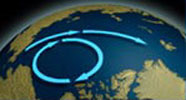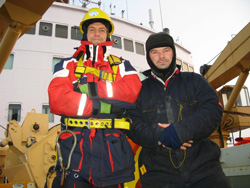Ben Lincoln and Ben Powell, Bangor University, WalesSeptember 5, 2012We are the only UK representatives on the cruise and are here to measure turbulence in the upper ocean. We have shipped our turbulence profiler over the Atlantic to St Johns to work on the Louis for our first experience of the Canadian Arctic. Bangor University is located in the north of Wales about 2 hours from the cities of Liverpool and Manchester and just across the Irish Sea from Dublin. The ocean science department is located in the small seaside village of Menai Bridge which is named after the 250 year old suspension bridge built by Thomas Telford. Located on the fast flowing Menai Strait and surrounded by the shallow waters of the Irish Sea we are experienced in measuring strong turbulence in seasonally stratified waters from our research vessel the RV prince Madog. However, in recent years we have been expanding our expertise into the polar oceans where the turbulent mixing of heat and freshwater play a crucial role in the earth’s climate. The instrument we are using to measure turbulence is a Rockland VMP 500 (Vertical Microstructure Profiler). This records the small sideways forces on piezoelectric sensors to measure the velocity shear from small eddies as it free-falls through the water up to a depth of 500m. We recover the VMP using a hydraulic winch and in order to allow the VMP to free-fall we use a hydraulic line puller to feed out excessive cable. We flew over from the UK to St Johns to mobilise our equipment so that when we flew out to meet the ship everything would be in place for us to start measurements. Our winch was welded down to the deck and a 3m boom was constructed for lifting the VMP over the gunwale. However like all well laid plans things changed. When we arrived on the ship the crew wanted to move one of the large foredeck winches to make way for the mooring deployments. This meant that our winch had to move to make way for it. This lead to the worrying situation of starting the cruise in heavy seas with our winch yet to be welded onto its new pad, and no sign of being ready for our first station. However someone upstairs felt sorry for us and the weather calmed and our winch was welded down with almost an hour before our first measurement. We have now been working out of the A-frame doors, which has been a great improvement since we don’t need to clear the gunwale when deploying the instrument. It does however mean I have to put on a harness every time we do a station which can be a real pain with cold fingers at 4am! So with one week to go we are getting ready to pack our equipment back into our little container for shipping to the UK and preparing for the series of flights which will eventually deliver us back home to Wales after 6 weeks away. Last updated: October 7, 2019 | |||||||||||||||||
Copyright ©2007 Woods Hole Oceanographic Institution, All Rights Reserved, Privacy Policy. | |||||||||||||||||



